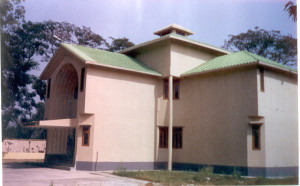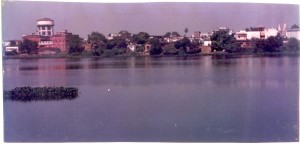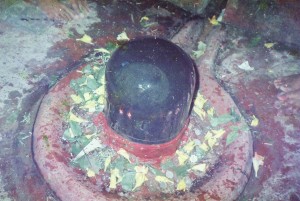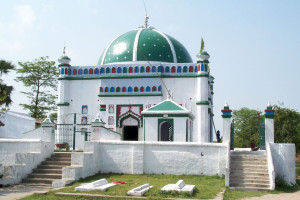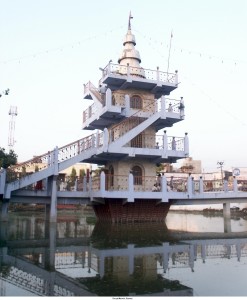In 1866 Champaran was made into a district with Motihari as its headquarters. On 1 December 1977 the Champaran district was divided into two district Purbi (East) Champaran and Paschim(West) Champaran and Motihari became the headquarters of East Champaran district. Purbi Champaran (Motihari) was to the first laboratory of Gandhian experiment in Satyagraha. It will not be very incorrect to say that is has been the spring board for India’s independence.One of the major industry of the district of Purba Champaran is Mehsi Button Industry. The pearl button industry at Mehsi has 160 units in 13
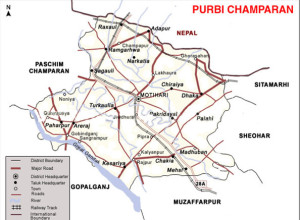 panchayats of Mehsi Anchal, employing 20,000 workers indirectly. Fishery is another occupation of the people of East Champaran. A large number of tanks and lakes, nearly 823 Government tanks and 161 private tanks covering 1920 acres of the land is used for fishery development. The economy of the district of Purba Champaran is dependant on agriculture. The farmers mainly grow Paddy. Apart from it, the farmers grow Sugar Cane, Jute, Lentils and Wheat, Maize, Pulses, Oil Seed. Mangos, Lichhi, Lemon, Guava, Banana, and Coconut are also grown in this region.
panchayats of Mehsi Anchal, employing 20,000 workers indirectly. Fishery is another occupation of the people of East Champaran. A large number of tanks and lakes, nearly 823 Government tanks and 161 private tanks covering 1920 acres of the land is used for fishery development. The economy of the district of Purba Champaran is dependant on agriculture. The farmers mainly grow Paddy. Apart from it, the farmers grow Sugar Cane, Jute, Lentils and Wheat, Maize, Pulses, Oil Seed. Mangos, Lichhi, Lemon, Guava, Banana, and Coconut are also grown in this region.
How To Reach
By Air ( Airport):-
The nearest airports to Motihari is Patna about 155 Km
By Rail :-
Motihari Station is an A grade category railway station and is one of the busiest stations of Samastipur railway division of East Central Railway. There is no direct train route from Patna. It is connected to some major cities of India viz Kolkata, Delhi, Mumbai, Amritsar,Kanpur, Guwahati, Jammu, Ahmedabad, Jaipur, Porbandar, Lucknow, Bareilly, Muzaffarpur and Darbhanga.
By Road:-
Well connected to other city through National Highway -28 .28A,104 SH-54,74 Other road – Dhaka Ghorasahan Rd,Chhapwa Harsidhi Sewraha Rd,Chakia Kesaria Sattarghat Rd,Motihari Madhubanghat Rd,Dhaka Pakri Dayal Road,Pachpakri Gurhenwa Road,Chakia Madhuban Rd,Pipra Link 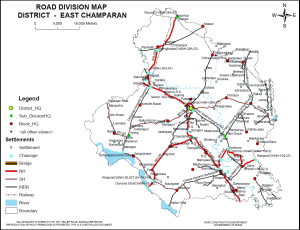 Road.Motihari is around 165 km from Patna, the capital of Bihar, 50 km from Bettiah, and 80 km from Muzaffarpur. The city is very close to Nepal. Birgunj, the second largest city of Nepal, is 55 km away.
Road.Motihari is around 165 km from Patna, the capital of Bihar, 50 km from Bettiah, and 80 km from Muzaffarpur. The city is very close to Nepal. Birgunj, the second largest city of Nepal, is 55 km away.
Motihari, the Headquarter of Purbi Champaran District is approximately 150 Km from Patna.
Popular tourist destinations
MOTIHARI BLOCK
Briksha Sthan Math :- One of the oldest structures in Motihari situated in Briksha Sthan Math is a temple of the guardian deity of Motihari, dating back to 1805.
The Gandhi Museum at Motihari:–
Mahatma Gandhi Memorial Park :-
Gandhi Memorial Stone Pillar :- It have been laid down in the memory of Mahatma Gandhi’s presence in Motihari on which Gandhiji’s courageous statement given before the Magistrate inscribed . According to record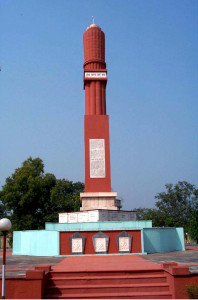
“The foundation stone of this Gandhi memorial pillar was laid on June 10, 1972 by the then Governor, Mr. D.K.Barooch, and it was dedicated to the nation by Mr. Vidyakar Kavi, a grandson, on 18 April 1978…. The 48 foot long Chunar stone pillar stands exactly on the place where Mahatma Gandhi was produced before the court of the then S.D.M., Motihari in violation of orders under section 144 Cr. P. C. as far back as April 18, 1917.”
Orwell’s birth place :- The cottage,where the famous author was born, lies in the midst of the town. A plaque commemorating has birth place stands outside the house. It is built for honouring the famous writer, George Orwel. He was one of the twentieth Century’s greatest writers and author of books Animal Farm and Nineteen Eighty-Four . He was born in Motihari in 1903. His father Richard Walmesley Blair was a deputy, posted in the opium department in Bihar. However, when he was one year old, George left for England with his mother and sister.
In 2003, Motihari discovered its role in Orwell’s life when a number of journalists arrived in the city for Orwell’s hundredth birthday. Local officials are making plans for the construction of a museum on Orwell’s life. The place may also be marked in the tourist map.
Monument of Khan Bahadur Azizul Huq :- It is built for honouring the Khan Bahadur Azizul Huq, the famous inventor of police fingerprint design and discovery. Khan Bahadur Azizul Huq was one of the two Indian police officers who worked with Edward Henry in the development of fingerprint classification, known as Henry Classification System, still widely used in the world. “It was Khan Bahadur Azizul Huq who evolved a mathematical formula to supplement Henry’s idea of sorting slips in 1024 pigeon holes, based on fingerprint patterns. Rai Bahadur Hem Chandra Bose made further contribution to the fingerprint science by evolving an extended system of subclassificaiton, a telegraphic code for finger impression and a system of single-digit classificaiton.
Both Haque and Bose eventually received honoraria and recognition from the Government of India. At the time of final approval of the honorarium for Haque, the Home Department (Government of India) noted, “It appears from the information now received that he (Haque) was Sir Edward Henry’s principal helper in perfecting the scheme and he actually himself devised the method of classification which is in universal use. He thus contributed most materially to a discovery which is of world wide importance and has brought a great credit to the police of India. Upon retirement from the Police service in Bengal and Bihar, Khan Bahadur Azizul Huq settled in Motihari, and he is buried there.
Motihari Jail(M.S.College) :- The present college building was a jail in the British rule and converted to college in 1948.This is the oldest college of Motihari. It is on the name of freedom fighter Shri Munshi Singh. It comes under Dr. Bhim Rao Ambedkar University, MUZAFFARPUR.
According to the All India Congress Committee (AICC), the farmers of Champaran were forced to sow Opium or Indigo on a certain portion of their farm plots. They then had to sell the same at a fixed price to the English Traders. This would cause losses and subsequent hardships to farmers. Furthermore, these crops would render the soil infertile and further increase the woes of the helpless farmer. Raj Kumar Shukla, a farmer in the region, invited Mohandas Karamchand Gandhi to come help them in their plight. Thus, Mahatma Gandhi decided to come to Motihari on 10 April 1917. The British authorities served notice on him to leave the Province of Bihar. Gandhiji refused to comply, saying that as an Indian he was free to travel anywhere in his own country. For this act of defiance he was detained in this jail . He was offered bail on the condition that he would leave the district. Gandhi reportedly refused to leave the district or put up bail. In his statement to the Court Gandhi reportedly said, “As a law-abiding citizen my first instinct would be, as it was, to obey the order served upon me. But I could not do so without doing violence to my sense of duty to those for whom I came. I feel that I could just now serve them by remaining in their midst. I could not therefore voluntarily retire. Amidst this conflict of duty I could only throw the responsibility of removing me from on the administration”. Subsequently, when mass disapproval of his arrest became evident, he was released, without payment of any bail. This was the first instance of the success of civil-disobedience as a tool to win freedom.
Bauriya Asthan :– Gandhiji stay here
Motijheel :- It divided the city in two part
Urdu Library :- It is one of the oldest libraries from the British rule.
Nagarik Pustakalaya :-
Gayatri Mandir :-
Ramsingh Chhatauni:- The KP Jayaswal Research Institute, during in the course of its Archaeological Explorations brought to light the site period Early medieval. Naurangia:- The KP Jayaswal Research Institute, during in the course of its Archaeological Explorations brought to light the site period NBPW phase. Patkhaulia:- The KP Jayaswal Research Institute, during in the course of its Archaeological Explorations brought to light the site period Early medieval. Ramgarhwan:- The KP Jayaswal Research Institute, during in the course of its Archaeological Explorations brought to light the site period Early medieval. Dostia:- The KP Jayaswal Research Institute, during in the course of its Archaeological Explorations brought to light the site period Gupta. Sarsaula:- The KP Jayaswal Research Institute, during in the course of its Archaeological Explorations brought to light the site period Gupta. Kunjan Tola:– The KP Jayaswal Research Institute, during in the course of its Archaeological Explorations brought to light the site period Early medieval. Sirasa Dih:- The KP Jayaswal Research Institute, during in the course of its Archaeological Explorations brought to light the site period Later Gupta. Gorhawa:- The KP Jayaswal Research Institute, during in the course of its Archaeological Explorations brought to light the site period Later Gupta. Batraulia:- The KP Jayaswal Research Institute, during in the course of its Archaeological Explorations brought to light the site period Gupta. Patkhaulia Tal Dih:- The KP Jayaswal Research Institute, during in the course of its Archaeological Explorations brought to light the site period Gupta. Jhitakahia:- The KP Jayaswal Research Institute, during in the course of its Archaeological Explorations brought to light the site period Early medieval. Harkaina:- The KP Jayaswal Research Institute, during in the course of its Archaeological Explorations brought to light the site period Gupta. Barawan:– The KP Jayaswal Research Institute, during in the course of its Archaeological Explorations brought to light the site period Gupta. Lokasa:- The KP Jayaswal Research Institute, during in the course of its Archaeological Explorations brought to light the site period Early medieval. Raysingha Dih:- The KP Jayaswal Research Institute, during in the course of its Archaeological Explorations brought to light the site period Early medieval. Jhitakahia Pokaha:- The KP Jayaswal Research Institute, during in the course of its Archaeological Explorations brought to light the site period Gupta. Bhenriharwa Roop Dih:- The KP Jayaswal Research Institute, during in the course of its Archaeological Explorations brought to light the site period Early medieval. Naurangia Tola Gangeya Dih:- The KP Jayaswal Research Institute, during in the course of its Archaeological Explorations brought to light the site period Gupta. Lakhaura Brahm Tola:- The KP Jayaswal Research Institute, during in the course of its Archaeological Explorations brought to light the site period Gupta.
Lakhaura:- It is situated about 13 km north of Motihari town. It is believed to have been the birthplace of the devout Child- Saint Dhruva.
Naurangia Dih:- The KP Jayaswal Research Institute, during in the course of its Archaeological Explorations brought to light the site period Gupta. Baraharwa:- The KP Jayaswal Research Institute, during in the course of its Archaeological Explorations brought to light the site period Gupta. Bhisa Garh (Lakhaura):- The KP Jayaswal Research Institute, during in the course of its Archaeological Explorations brought to light the site period Gupta
ARERAJ BLOCK
Bahadurpur Garh:- The KP Jayaswal Research Institute, during in the course of its Archaeological Explorations brought to light the site period Early medieval.
Areraj:- The KP Jayaswal Research Institute, during in the course of its Archaeological Explorations brought to light the site period Early medieval.
Someshwar Nath Mahadev Temple( Areraj) :-
It is situated in Areraj which is 30 km south west of Motihari. It is one of the oldest temples in Hindu mythology. This ancient temple 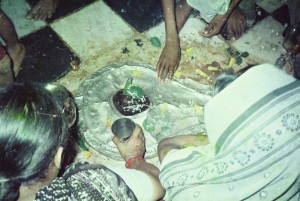 enshrines Lord
enshrines Lord 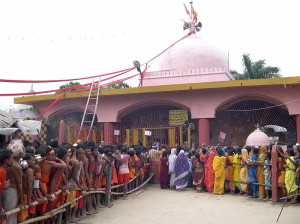 Shiva as the presiding deity. The idol is installed in a pit. Worshippers have to descend a few steps to offer puja. Near to Shiv temple there is a river called Telie. It attracts lakhs of pilgrims from other districts as well as Nepal on the occasion of Shrawani Mela during July-August.
Shiva as the presiding deity. The idol is installed in a pit. Worshippers have to descend a few steps to offer puja. Near to Shiv temple there is a river called Telie. It attracts lakhs of pilgrims from other districts as well as Nepal on the occasion of Shrawani Mela during July-August.
Thakur Mandir :-
Hanuman Mandir :-
Durga Mandir :-
Saraswati Mandir :-
Akalua Mahadev Mandir :-
Gayatri Shakti Peeth :-
Jalpa Bhawani :-
Bhearo Sthan:-
Janekha:- The KP Jayaswal Research Institute, during in the course of its Archaeological Explorations brought to light the site period NBPW Phase
Lauriya Ashokan Pillar:-
This Place is only 2 km west to Areraj.
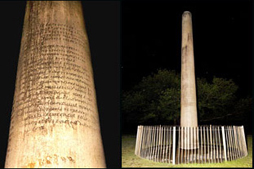 The Ashoka Pillar with inscription(Pillar Edicts I, II, III, IV, V, VI) thereon is also called Laur Baba or Phallus of Siva and is worshipped by the local inhabitants. This Pillar has no capital.
The Ashoka Pillar with inscription(Pillar Edicts I, II, III, IV, V, VI) thereon is also called Laur Baba or Phallus of Siva and is worshipped by the local inhabitants. This Pillar has no capital.
It is a single block of polished sandstone 36.5 feet in height above the ground with a base diameter of 41.8 inches and the top it measures about 37.6 inches.
According to Jayaswal Research Institute Archaeological Explorations this site belongs to NBPW phase period.
Hardiya:- The KP Jayaswal Research Institute, during in the course of its Archaeological Explorations brought to light the site period Chalcolithic. Rarhiyan:- The KP Jayaswal Research Institute, during in the course of its Archaeological Explorations brought to light the site period Chalcolithic. Kamalua:– The KP Jayaswal Research Institute, during in the course of its Archaeological Explorations brought to light the site period Gupta. Govindganj:- The KP Jayaswal Research Institute, during in the course of its Archaeological Explorations brought to light the site period NBPW phase.
Jhakhara Dih:- It is 3 km from Areraj to the south.
According to Jayaswal Research Institute Archaeological Explorations this site belongs to NBPW phase period.
Chandi Asthan:- The KP Jayaswal Research Institute, during in the course of its Archaeological Explorations brought to light the site period Chalcolithic. Khajuria:- The KP Jayaswal Research Institute, during in the course of its Archaeological Explorations brought to light the site period Later Gupta.Nawada:- The KP Jayaswal Research Institute, during in the course of its Archaeological Explorations brought to light the site period NBPW phase. Rarhiya Phulwari Dih:- The KP Jayaswal Research Institute, during in the course of its Archaeological Explorations brought to light the site period Gupta.Mamrakha Babu Tola:- The KP Jayaswal Research Institute, during in the course of its Archaeological Explorations brought to light the site period NBPW phase.
Malahi:- The KP Jayaswal Research Institute, during in the course of its Archaeological Explorations brought to light the site period Kushan
Ashram in Malaahi :- Ramarshi Deo Trivedi “Rishi Ji” (1900-1976) from Mamarkha (8 km from Areraj) became influenced by Gandhiji. When Gandhiji left for the national movement, Ramarshi Dev Trivedi continued the freedom movement in Champaran. Rishi ji was one of the most renowned freedom fighters of Bihar. He was a very close associate of Dr. Rajendra Prasad and Vinoba Bhave, who addressed him as ‘Rishi ji’. He was also known as Badshah as he established a parallel government in Champaran which was known as Badshah ki Sarkar. A special task force was formed by the Britishers to arrest him. He was arrested in 1942 and was sentenced 58 years of imprisonment. He was released in 1947, after independence, and later he spent his days in his Ashram in Malaahi
Mura:- The KP Jayaswal Research Institute, during in the course of its Archaeological Explorations brought to light the site period NBPW phase.
Kauaha :- It is 7 KM west to Areraj. It is about 1 KM from Balha Chowk.
SANGRAMPUR BLOCK
Sangrampur :- A place Sangrampur about 12 km in the south of this place is a very historical place.
Gobindaganj Ghat:- The famous Gobindaganj Ghat and Ezra Nawada village is just 7 km from Areraj. At Gobindganj Ghat, Each year on the occasion of Nahan(Katik Purnima) after 9 days of Chhath Puja, Animal fare takes place. Which happen to be the Biggest Pashu Animal Fair of Bihar.
Radha Krishna Math(Madhubani):- Madhubani is 10 km from Areraj. Madhubani is very Famous Panchayat, it is divided in to four part East madhubani, West madhubani, north and south madhubani.
Bhatkarja Dih:- The KP Jayaswal Research Institute, during in the course of its Archaeological Explorations brought to light the site period Early medieval. Bhawanipur:- The KP Jayaswal Research Institute, during in the course of its Archaeological Explorations brought to light the site period NBPW phase. Sangrampur Mathia:– The KP Jayaswal Research Institute, during in the course of its Archaeological Explorations brought to light the site period Kushan. Dariyapur:- The KP Jayaswal Research Institute, during in the course of its Archaeological Explorations brought to light the site period Kushana. Ijara Dih:- The KP Jayaswal Research Institute, during in the course of its Archaeological Explorations brought to light the site period Shunga. Rampurwa Dih:- The KP Jayaswal Research Institute, during in the course of its Archaeological Explorations brought to light the site period Kushana. Madhubani Dubey Tola:– The KP Jayaswal Research Institute, during in the course of its Archaeological Explorations brought to light the site period Kushan. Shyampur Dih:- The KP Jayaswal Research Institute, during in the course of its Archaeological Explorations brought to light the site period Gupta
TURKAULIA BLOCK
Madhopur:- The KP Jayaswal Research Institute, during in the course of its Archaeological Explorations brought to light the site period Early medieval. Shankar Saraiya:- The KP Jayaswal Research Institute, during in the course of its Archaeological Explorations brought to light the site period Early medieval. Khagani Dih:- The KP Jayaswal Research Institute, during in the course of its Archaeological Explorations brought to light the site period NBPW phase. Babhanauliya Dih:- The KP Jayaswal Research Institute, during in the course of its Archaeological Explorations brought to light the site period Later Gupta. Jamuniya Hardiya:- The KP Jayaswal Research Institute, during in the course of its Archaeological Explorations brought to light the site period Kushan. Sanpahi:-The KP Jayaswal Research Institute, during in the course of its Archaeological Explorations brought to light the site period Gupta.
HARSIDHI BLOCK
Jagapakar:- The KP Jayaswal Research Institute, during in the course of its Archaeological Explorations brought to light the site period Early medieval. Gay Ghat Dih:- The KP Jayaswal Research Institute, during in the course of its Archaeological Explorations brought to light the site period Early medieval. Misi Tola Olha:- The KP Jayaswal Research Institute, during in the course of its Archaeological Explorations brought to light the site period Neolithic. Danahi Dih:- The KP Jayaswal Research Institute, during in the course of its Archaeological Explorations brought to light the site period NBPW phase. Ghiwadhar:– The KP Jayaswal Research Institute, during in the course of its Archaeological Explorations brought to light the site period Early medieval. BaramaswarDih:– The KP Jayaswal Research Institute, during in the course of its Archaeological Explorations brought to light the site period Neotithic. Olha Dih:- The KP Jayaswal Research Institute, during in the course of its Archaeological Explorations brought to light the site period NBPW phase.
PAHARPUR BLOCK
Paharpur:-
Satahan Kachahari Tola:- The KP Jayaswal Research Institute, during in the course of its Archaeological Explorations brought to light the site period NBPW phase. Sareya Briti Tola:– The KP Jayaswal Research Institute, during in the course of its Archaeological Explorations brought to light the site period Early medieval. Ekderwa Dih:- The KP Jayaswal Research Institute, during in the course of its Archaeological Explorations brought to light the site period NBPW phase.. Maurahan:- The KP Jayaswal Research Institute, during in the course of its Archaeological Explorations brought to light the site period NBPW phase. Lakhanipur:- The KP Jayaswal Research Institute, during in the course of its Archaeological Explorations brought to light the site period NBPW phase. Sareya Chainpatti:- The KP Jayaswal Research Institute, during in the course of its Archaeological Explorations brought to light the site period Shunga. Sonawal Uttar Patti:- The KP Jayaswal Research Institute, during in the course of its Archaeological Explorations brought to light the site period NBPW phase. Dhani Tola:- The KP Jayaswal Research Institute, during in the course of its Archaeological Explorations brought to light the site period NBPW phase. Tikulia Dih:– The KP Jayaswal Research Institute, during in the course of its Archaeological Explorations brought to light the site period Kushan. Narkatia:- The KP Jayaswal Research Institute, during in the course of its Archaeological Explorations brought to light the site period Neolithic. Bilari Tikulia:- The KP Jayaswal Research Institute, during in the course of its Archaeological Explorations brought to light the site period Kushan. Sareya Dubey Tola:- The KP Jayaswal Research Institute, during in the course of its Archaeological Explorations brought to light the site period NBPW phase.. Tejpurwa Dih:-The KP Jayaswal Research Institute, during in the course of its Archaeological Explorations brought to light the site period Neolithic.
CHAKIA BLOCK
Bedivan Madhuban:- The KP Jayaswal Research Institute, during in the course of its Archaeological Explorations brought to light the site period NBPW phase.
Sugar mill(Chakia):-During the British rule the champaran sugar mill was founded in 1905, right now the sugar factory is closed since 1995.
Fort ruins and Stupa (Sagardih):- The village contains the remains of an ancient fort the shape of which is an irregular square, 450 ft. long on each side, with large round bastions at the corners and in the middle of each face.
According to Jayaswal Research Institute Archaeological Explorations this site belongs to Late NBPW phase period.
Sitakund :- Sitakund is situated near the Pipra railway station, 16 kms to the southeast of Motihari and about half kilometers to the north of Madhuban on the Sikrahna river.
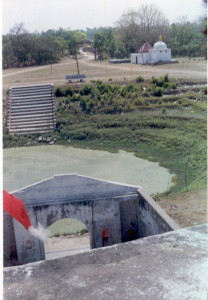 The village contains the remains of an ancient fort. Inside the fort is a holy tank, to which the name Sitakund peculiarly applies as Sita, the wife of Ram, bathed there. It is a deep circular pond surrounded by brick walls with four ghats leading down to it. A great fair is held there on the Ramnavami when several thousands of pious Hindus assemble to do honour to Ram and Sita. The are several temples and shrines round it; the principal temple, which stands near the western side of the tank, enshrines images Sun, Hanuman and Vishnu,
The village contains the remains of an ancient fort. Inside the fort is a holy tank, to which the name Sitakund peculiarly applies as Sita, the wife of Ram, bathed there. It is a deep circular pond surrounded by brick walls with four ghats leading down to it. A great fair is held there on the Ramnavami when several thousands of pious Hindus assemble to do honour to Ram and Sita. The are several temples and shrines round it; the principal temple, which stands near the western side of the tank, enshrines images Sun, Hanuman and Vishnu, 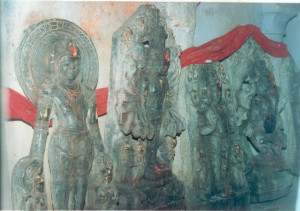 an image of Ravana, with 20 arms and 10 heads, five of which only are shown on the carving; another of Mahish-mardini or Durga in the act of killing a buffalo demon and two images of Ganesha, one seated with four arms and one dancing with eight arms, etc.
an image of Ravana, with 20 arms and 10 heads, five of which only are shown on the carving; another of Mahish-mardini or Durga in the act of killing a buffalo demon and two images of Ganesha, one seated with four arms and one dancing with eight arms, etc.
According to Jayaswal Research Institute Archaeological Explorations this site belongs to Early medieval period.
CHIRAIYA BLOCK
Nona:- The KP Jayaswal Research Institute, during in the course of its Archaeological Explorations brought to light the site period Early medieval. Sarsanwa:- The KP Jayaswal Research Institute, during in the course of its Archaeological Explorations brought to light the site period Gupta. Mahuahi:- The KP Jayaswal Research Institute, during in the course of its Archaeological Explorations brought to light the site period Chalcolithic.
SUGAULI BLOCK
Mahadev Tola:- The KP Jayaswal Research Institute, during in the course of its Archaeological Explorations brought to light the site period Kushan.
Sugauli :– It is located 28 KM towards west from District head quarters Motihari. It is a Block head quarter.Sugauli has great role in India’s independence war. Sugauli is the part of Satyagraha movement what Gandhi ji has started from the Champaran. This is the place where Nepalese Treaty was signed between British India and Nepal in March 1816 and was headquarter of General Ochterlony during the last Nepalese war. Cantonments were built there after the Napalese war and occupied in the National Movement of 1857 by thr 12 th regiment of Irregular Horse commanded by Major Holmes.
Temple(Sugauli) :-
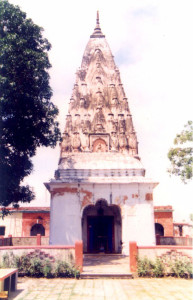 A fine temple is standing in the ruins palace built as a summer residence by one of the Maharaja of Bettiah on the bank of Sikrahna river in
A fine temple is standing in the ruins palace built as a summer residence by one of the Maharaja of Bettiah on the bank of Sikrahna river in
.
ADAPUR BLOCK
Adapur :- It is a very old famous town . Mahatma Gandhi had already visited this place on April 17, 1917. It is parallel to the border of Nepal and is situated at a distance of 13 km by rail from Raxaul.
Chandraman:- The KP Jayaswal Research Institute, during in the course of its Archaeological Explorations brought to light the site period Early medieval. Jhitkatiya:- The KP Jayaswal Research Institute, during in the course of its Archaeological Explorations brought to light the site period Gupta
PIPRA KOTHI BLOCK
Kasawa:- The KP Jayaswal Research Institute, during in the course of its Archaeological Explorations brought to light the site period Kushan. Chainpur:- The KP Jayaswal Research Institute, during in the course of its Archaeological Explorations brought to light the site period Gupta. Chand Saraiya:- The KP Jayaswal Research Institute, during in the course of its Archaeological Explorations brought to light the site period Early medieval. Kachhapura:– The KP Jayaswal Research Institute, during in the course of its Archaeological Explorations brought to light the site period Early medieval. Manjharia:- The KP Jayaswal Research Institute, during in the course of its Archaeological Explorations brought to light the site period Early medieval.
Kabir Santi Stup:- It is situated 10 km from Motihari in Belwatiya village. It is eight world famous Kabir Santi Stup in India and first in Bihar.It is established by Mahanth Ramsanehi Das in year 2002.
Kabir Asaram:- It is situated 10 km from Motihari in Belwatiya village. It is established by Mahanth Keswao Shaheb in year 1875..
BANJARIYA BLOCK
Britian Loknathpur Dih:- The KP Jayaswal Research Institute, during in the course of its Archaeological Explorations brought to light the site period Gupta. Kharawa Musahari Toli:- The KP Jayaswal Research Institute, during in the course of its Archaeological Explorations brought to light the site period Kushan. Brahmpuri:– The KP Jayaswal Research Institute, during in the course of its Archaeological Explorations brought to light the site period Later Gupta. Pacharukha Dih:- The KP Jayaswal Research Institute, during in the course of its Archaeological Explorations brought to light the site period Gupta. Pararia:- The KP Jayaswal Research Institute, during in the course of its Archaeological Explorations brought to light the site period Later Gupta. Amawa Tola:- The KP Jayaswal Research Institute, during in the course of its Archaeological Explorations brought to light the site period Early medieval.
GOVINDGANJ BLOCK
Jharwara:- The KP Jayaswal Research Institute, during in the course of its Archaeological Explorations brought to light the site period Early medieval. Lauriya Areraj:- The KP Jayaswal Research Institute, during in the course of its Archaeological Explorations brought to light the site period NBPW phase.
KESARIA BLOCK
Sarotar:–
The KP Jayaswal Research Institute, during in the course of its Archaeological Explorations brought to light the site period NBPW phase.
Sarottar lake :- It is about 40 km from Motihari town and located around Dhangarhha chowk adjacent to NH-28A. The lake stretching over 1500 acres. It home to an estimated 50 species of resident birds and annual nesting ground for over 40 species, which fly in from as far off places round the world among them are Red Crested Pochards and Coots, Dove, Sora,Virginia, Snipe, Teal , Wood Cock, Bronze Winged Jacanas, Pond Herons, Egrets, Swamp Partridges etc. Some water birds come here from the European coasts to escape the freezing cold there. They breed here in warmer environment and with the onset of summer in early February and March they return to their homes with their offsprings. Some foreign birds started arriving at Lake in the first week of August.
Manohar Chapra:- The KP Jayaswal Research Institute, during in the course of its Archaeological Explorations brought to light the site period NBPW phase. Khap Gopalpur Baishakhawa:- The KP Jayaswal Research Institute, during in the course of its Archaeological Explorations brought to light the site period Early medieval. Nayagaon:- The KP Jayaswal Research Institute, during in the course of its Archaeological Explorations brought to light the site period NBPW phase. Lohargawan:- The KP Jayaswal Research Institute, during in the course of its Archaeological Explorations brought to light the site period Later Gupta. Khijirpura:- The KP Jayaswal Research Institute, during in the course of its Archaeological Explorations brought to light the site period Late NBPW phase. Khajuria Dih:– The KP Jayaswal Research Institute, during in the course of its Archaeological Explorations brought to light the site period Early medieval. Lala Chapra:- The KP Jayaswal Research Institute, during in the course of its Archaeological Explorations brought to light the site period Early medieval. Kesaria:- The KP Jayaswal Research Institute, during in the course of its Archaeological Explorations brought to light the site period NBPW phase.
Stone Pillar (Kesaria):- ASI explore Archaeological Explorations in Year 1970-71 Discoved a black stone pillar
Keshwarnath Temple :-
It is situated in Kesaria. During the excavation of canal in 1969 it is found.
According to local tradition, it is believed to belong to an ancient temple established by Raj Ben.. According to the same tradition,
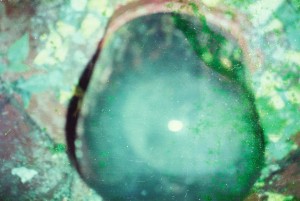 it is believed that the shivalingam obtained during the canal excavations is identical to the one described in the Agni Purana.
it is believed that the shivalingam obtained during the canal excavations is identical to the one described in the Agni Purana.
Ashram:- An ashram established on the banks of a small rivulet to the north of the Kesariya Police Station, during the first phase of Gandhi’s freedom struggle. At that time it became the focal point of political activities. This ashram was organized on the pattern of the Sabarmati ashram. This was the first ashram where khadi was introduced and publicized. So long as the evil eyes of the British did not set on it, this ashram provided much momentum to Gandhiji’s swadeshi and political movement. The principal roles in these movements were played by Shri Saryu Prasad and Shri Baidyanath Marwari.
Gandhi Library:- It was an important institution in the freedom struggle. This library was established only after getting a charter from Gandhiji himself.Shivanandan Prasad Varma, a resident of Darbhanga, played a leading role in the freedom movement. He resigned from his job as a teacher and contributed actively towards the establishment of the library.Similarly, a businessman of Birganj, Nepal, Shri Baiju Lal Marwari, also gave full co-operation in the establishment of the library.Shri Ganga Prasad contributed in the opening of the library. Saryu Babu was very closely associated with the establishment and expansion of the library. Even today, this most vibrant Gandhi Library, is very popular in the educational arena of Kesariya. Many priceless books are available here.
Kesaria Stupa or Buddhist Stupa (Tajpur Deur)::-
Kesaria Stupa locally known as Deura is about 120 K.M. from Patna and 45 km north-west from Vaishali. It is situated in the south-western corner of the district. Historical importance of Bihar has been established again with the discovery of “biggest ever Buddhist Stupa “of the height of 104 feet. The stupa was discovered in 1958 during an excavation led by archaeologist K.K. Muhammad of the ASI. The stupa dates to between 200 AD and 750 AD, and may have been associated with the 4th century ruler Raja Chakravarti. Lord Buddha on his last Journey spent on memorable night at Kesaria. Here he made source sensational announcements, which was later on recorded in Buddhist Jataka – Story.
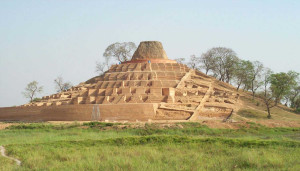 Its history dates back to the final visit to of the Buddha to Vaishali just before his Mahaparinirvana at Kushinagar. As the Scriptures mention that as the Buddha left Vaishali on his ‘final journey’ the devotees from this kingdom followed him for quite a distance to a place known as Kessaputta. As evening set in, the Blessed One requested them to return home. The Vajjian people knew that they would not see the Buddha again. As such they asked the Lord for a mark or item by which they would remember him. So to oblige them the Compassionate One gave them his begging bowl and then preached to them the Kalama Sutta. After his demise, at some period of time, the Vajjian devotees built a Stupa at this site and buried the ‘begging bowl’ in it.Buddha here at Kesaria said that in his previous births he ruled as Chakravarti Raja.
Its history dates back to the final visit to of the Buddha to Vaishali just before his Mahaparinirvana at Kushinagar. As the Scriptures mention that as the Buddha left Vaishali on his ‘final journey’ the devotees from this kingdom followed him for quite a distance to a place known as Kessaputta. As evening set in, the Blessed One requested them to return home. The Vajjian people knew that they would not see the Buddha again. As such they asked the Lord for a mark or item by which they would remember him. So to oblige them the Compassionate One gave them his begging bowl and then preached to them the Kalama Sutta. After his demise, at some period of time, the Vajjian devotees built a Stupa at this site and buried the ‘begging bowl’ in it.Buddha here at Kesaria said that in his previous births he ruled as Chakravarti Raja.
The excavation reveals the terraces with “Pradakshina path” around the stupa. Move important finding is a number of figures of Lord Buddha in “Bhumi Sparsh Mudra” and other sitting image. These figures are made of soil and pebbles in each layer. Excavation also discovered a staircase 80 cm wide on the south-west corner connecting the upper two terraces. The staircase is concealed within the polygonal designs between the cells and is not prominently visible in the general view of the stupa.The earthen lamp, decorated bricks and other potteries are other point of attraction.
According to some archaeologists, this monument dates back to 200 AD to 750 AD and was built by licchavis of Vaishali before Buddha attained Nirvana . Chinese pilgrim Hiuen Tsang had visited this site of Stupa as per his diary in the seventh century.
Before the excavation of this,The local people call this Stupa as Devala, “means the house of god” and believed that inside it there is a temple of ‘Lord shiva’ which is built by king Bhima .
In the 1998 excavation, the place around the stupa was found to house significant items, like Islamic coins, arrow heads, copper and terracotta items, earthen lamps, decorated bricks, etc. A number of images of Lord Buddha, in ‘Bhoomi Sparsh Mudra’ and other sitting postures, were also found.
Raniwas :- About 1.5 km to the north-east of Deora was the Queen of Raja Ben’s Palace . The pond in which she used to take her bath was famous as the Gangeya Taal. The excavation at the Raniwas site took place in 1862. These excavation confirmed the fact that there was also a Buddhist Vihara at the site . A huge statue of Lord Buddha was found here , which was stolen in 1868 by the Bengali Babu of the Ramgarh Indigo Factory. Even today the high earthen mound at the spot of the Raniwas reminds people of its rich heritage. The place known as Raja Bens Fort was badly damaged in the earthquake of 1938.
Husaini:- The KP Jayaswal Research Institute, during in the course of its Archaeological Explorations brought to light the site period Late NBPW phase.
Huseni Lake :- It is situated about 53 kms south-west from Motihari and about 8 km weast- north of Kesaria. The lake attracts large number of game birds.
Dhekenha Math :– It is about 7 km south of Block headquarters of Kesaria. A resident of the Ballia district, Shri Bhujawan Pandit, provided a handwritten account of the two hundred year old history of the Dhekenha Math. This was revised, annotated and published by Shri Rupal Pandit in 1915. Dhekanha Math was established under the Vaishnava tradition. No place is given to caste and dynastic traditions in the selection of Mathadi Shas, which now runs up to five generations.
In the tradition of the Guru-shishya, and to mark Shri Ram Janmotsava, a Mela is held at Dhekhanha during Asadha Purnima or Guru Purnima. Also, during Chaitra Ramnavami, hundreds of thousands of people visit this place.
Janaki Nagar near Kesaria :-
The model of the world’s largest Hindu temple in Bihar, Once completed, it will be world’s largest Hindu temple, spread over 190 acres.At 405 feet, the proposed Viraat Ramayan Mandir in Motihari district will be nearly double the height of the renowned 215-feet-high Angkor Wat temple in Cambodia, so far the largest Hindu temple in the world.Chief minister Nitish Kumar will unveil the temple model at Mahavir Mandir. The function will be inaugurated by Dwarka Peeth Shankaracharya Swami Swaroopanand Saraswati.“Originally, it was planned to be 150-feet high, but later the proposed height was increased to 222 feet, and finally to 405 feet.”The Viraat Ramayan Mandir will have a 20,000-seating capacity in the hall facing the main temple, which will house the statues of Lord Ram, Sita, Lav and Kush.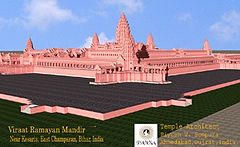
“No temple in the world has such a huge seating capacity. The complex will have a total of 18 temples with high spires. The Shiva temple will have the largest Shiva Linga in the world,”The temple has been designed by architect Piyush Sompura from Ahmedabad, who will also be present during the model’s unveiling.
Plan of Temple
CHAURADANO BLOCK
Juafar Dih:– The KP Jayaswal Research Institute, during in the course of its Archaeological Explorations brought to light the site period NBPW phase. Darpa:- The KP Jayaswal Research Institute, during in the course of its Archaeological Explorations brought to light the site period Early medieval. Dhapahar Ghotaka Tola:- The KP Jayaswal Research Institute, during in the course of its Archaeological Explorations brought to light the site period Gupta. Tinkoni:- The KP Jayaswal Research Institute, during in the course of its Archaeological Explorations brought to light the site period Early medieval. Duho Suho:- The KP Jayaswal Research Institute, during in the course of its Archaeological Explorations brought to light the site period NBPW phase. Pipara:- The KP Jayaswal Research Institute, during in the course of its Archaeological Explorations brought to light the site period Gupta. Belwa Dih:- The KP Jayaswal Research Institute, during in the course of its Archaeological Explorations brought to light the site period Early medieval. Dhapahar Juafar:- The KP Jayaswal Research Institute, during in the course of its Archaeological Explorations brought to light the site period NBPW phase. Garahal:- The KP Jayaswal Research Institute, during in the course of its Archaeological Explorations brought to light the site period Later Gupta
KOTWA BLOCK
Belwa Madho:- The KP Jayaswal Research Institute, during in the course of its Archaeological Explorations brought to light the site period Early medieval. Mahammada Dih:– The KP Jayaswal Research Institute, during in the course of its Archaeological Explorations brought to light the site period Early medieval. Bhopatpur:- The KP Jayaswal Research Institute, during in the course of its Archaeological Explorations brought to light the site period Early medieval. Bathana Dih:– The KP Jayaswal Research Institute, during in the course of its Archaeological Explorations brought to light the site period Early medieval. Gamaharia Dih:– The KP Jayaswal Research Institute, during in the course of its Archaeological Explorations brought to light the site period NBPW phase. Bangara Dih:- The KP Jayaswal Research Institute, during in the course of its Archaeological Explorations brought to light the site period Early medieval. Pakari Ashok Dih:– The KP Jayaswal Research Institute, during in the course of its Archaeological Explorations brought to light the site period Early medieval. Dumara Mishra Tola:– The KP Jayaswal Research Institute, during in the course of its Archaeological Explorations brought to light the site period Early medieval. Dipan Dih:– The KP Jayaswal Research Institute, during in the course of its Archaeological Explorations brought to light the site period NBPW phase. Bairagi Tola Kararia:- The KP Jayaswal Research Institute, during in the course of its Archaeological Explorations brought to light the site period NBPW phase. Machhargawan Dih:- The KP Jayaswal Research Institute, during in the course of its Archaeological Explorations brought to light the site period Early medieval. Baraharwa Kala:- The KP Jayaswal Research Institute, during in the course of its Archaeological Explorations brought to light the site period NBPW phase. Ahiraulia Dih:- The KP Jayaswal Research Institute, during in the course of its Archaeological Explorations brought to light the site period Gupta. Fattetola:- The KP Jayaswal Research Institute, during in the course of its Archaeological Explorations brought to light the site period NBPW phase. Rohua Khas:- The KP Jayaswal Research Institute, during in the course of its Archaeological Explorations brought to light the site period NBPW phase. Nawada Dih:- The KP Jayaswal Research Institute, during in the course of its Archaeological Explorations brought to light the site period Early medieval.. Kararia:- The KP Jayaswal Research Institute, during in the course of its Archaeological Explorations brought to light the site period NBPW phase. Fatuha Nawada:– The KP Jayaswal Research Institute, during in the course of its Archaeological Explorations brought to light the site period Early medieval. Rani Chhapra:- The KP Jayaswal Research Institute, during in the course of its Archaeological Explorations brought to light the site period Early medieval.
DHAKA BLOCK
Barharwa Lakhansen :-
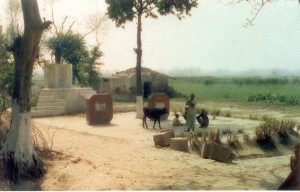 A village at a distance of about 30 km to the east of Motihari, where Gandhiji stay in the house of late Shiv gulam lal bakshi and established his first school named Buniyadi Bidyalaya on dated 13 10.1917 and also started Sikchha Dan Andolan .
A village at a distance of about 30 km to the east of Motihari, where Gandhiji stay in the house of late Shiv gulam lal bakshi and established his first school named Buniyadi Bidyalaya on dated 13 10.1917 and also started Sikchha Dan Andolan . 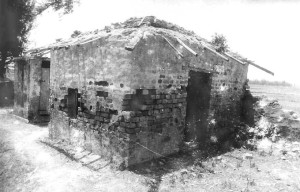 Honourable C.M Shri Nitish kumar announce to connect this village to Gandhi Circuit on dated 30.4.2010 in there Vishwas Yatra.
Honourable C.M Shri Nitish kumar announce to connect this village to Gandhi Circuit on dated 30.4.2010 in there Vishwas Yatra.
MADHUBAN BLOCK
Madhuban :– It is belived that there is a famous temple more than 2000 years old. It is a place of considerable religious importance for the Jains . The Samo- Shoran temple and Bhomiyaji Asthan are very beautiful places of attraction . The Dharm Mangal Vidyapith temple is under construction.
Here is a third school which was opened on the 17 th Januory, 1918 by Gandhiji according to AICC report.
GHORASAHAN BLOCK
Nonaura :- It is situated 5 km south of Ghorasahan famous for a weak fair on the eve of Dusshera.
PHENHARA BLOCK
Phenhara :- It is a small town in this district. It has a very old middle school, which was established before 1930. Mahatma Gandhi once visited this place. Phenhara provides an example of Hindu and Muslim unity. Phenhara is a well educated and politically aware town. Kesariya is in the south eastern portion of the district.
Mazar of Hazrat Maulana Mohammad Abdul Aziz (Rh) :- The mazar of Hazrat Maulana Mohammad Abdul Aziz (rh) is in the Kodaria village. He(rh) is a very powerful saint of Awaisiya silsila. His Urs is celebrated every year on 11th and 12th Fasli Vaishakha (according to the Hindu calendar). On the evening of 11th Fasli Vaishakha, there is a Miladun Nabi(SAW) after the magrib nimaz, then Salat-o-Salam and dua. And on the 12th Fasli Vaishakha at 10:30 am, the chaders are taken from his room, where he died, to his Mazar Sharif. Then there is Chader Poshi and Milad-e-Nabi. After Milad there happens Salat-o-salam and dua. After dua, a lunch for all the devotees.
MEHSI BLOCK
Mirza Halim Shah Mazar (Mehsi) :-
Nagrik Pustakalaya(Mehsi) :-
Tirhut Vidyalaya(Mehsi) :- It is an old High School of the English period,
NARKATIAGANJ BLOCK
Baikunth Nath temple :- A idol of Shiva, Parvati and Ganesh in a single idol is attraction of this place. This temple came in existence from 2002. According to local tradition, it is believed that The idol of Shiva, Parvati and Ganesh came out automatically from the deep surface of the earth.
RAXAUL BLOCK
Raxaul :- It is the border town of India with Nepal. This town is known as the Gateway to Nepal. It is connected by NH28A and is 32 km away from Chhapawa on NH28A, 52 km from Motihari the District Town and 60 km from Bettiah – the District town of West Champaran. Now this town has been made the Sub-divisional town under the District of East Champaran. Birganj – the Second Big City of Nepal is just 3 km away from this town.
Surya mandir:-
Jama Masjid:- It is very old Masjid on Indo Nepal border , situated at Raxaul main bazar near SBI Bank and police station on NH 28.
